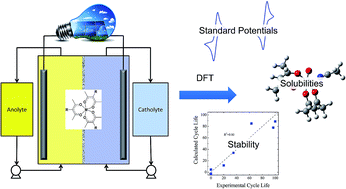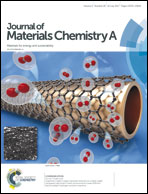Predicting the potentials, solubilities and stabilities of metal-acetylacetonates for non-aqueous redox flow batteries using density functional theory calculations†
Abstract
New active materials are needed to improve the performance and reduce the cost of non-aqueous redox flow batteries (RFBs) for grid-scale energy storage applications. Efforts to develop better performing materials, which have largely been empirical, would benefit from a better understanding of relationships between structural, electronic and RFB-relevant functional properties. This paper focuses on metal-acetylacetonates, a class of metal coordination complexes that has shown promise for use in RFBs, and describes correlations between their experimentally measured standard potentials, solubilities, and stabilities (cycle lifes), and selected chemical, structural and electronic properties determined from Density Functional Theory (DFT) calculations. The training set consisted of 16 complexes including 5 different metals and 11 different substituents on the acetylacetonate ligand. Standard potentials for those compounds were calculated and are in good agreement with experimentally measured results. A predictive equation based on the solvation energies and dipole moments, two easily computed properties, reasonably modeled the experimentally determined solubilities. Importantly, we were able to identify a descriptor for the stability of acetylacetonates. The experimentally determined stability, quantified as the cycle life to a given degree of degradation, correlated with the percentage of the highest occupied (HOMO) or lowest unoccupied molecular orbital (LUMO) on the metal of the complex. This percentage is influenced by the degree of ligand innocence (irreducibility), and complexes with the most innocent ligands yielded the most stable redox reactions. To this end, VO(acetylacetonate)2 and Fe(acetylacetonate)3, with nearly 80% of the HOMO and LUMO on the metal, possessed the most stable oxidation and reduction half-reactions, respectively. The structure–function relationships and correlations presented in this paper could be used to predict new, highly soluble and stable complexes for RFB applications.



 Please wait while we load your content...
Please wait while we load your content...